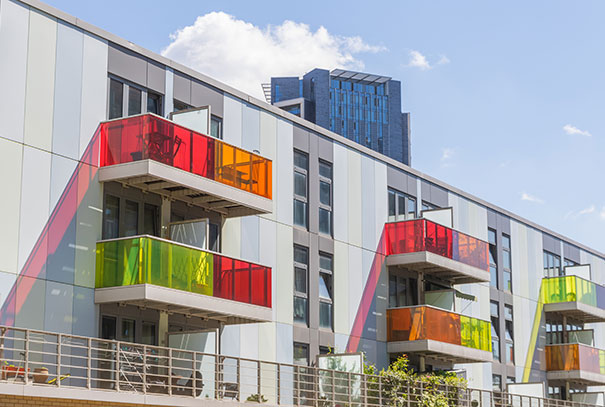
The latest fund is predominately aimed at supporting leaseholders in the private sector, who are currently facing significant costs to replace existing cladding systems.
To support our clients, we want to highlight the issues around different types of cladding and how the insurance market is responding. Cladding in any form is generally not deemed an attractive risk feature when reviewing a property and negotiating terms with underwriters, unsurprisingly because of the increased risk posed by fire and the potential of it spreading to surrounding properties. Historically some infill materials in cladding panels have been deemed to be highly flammable; the outer membranes are easily damaged and the panels allow for an increased rate in the spread of a fire.
The types of infill are generally quite standard across the industry and can be categorised as follows:
| Infil Materials | |
| EPS / XPS – Expanded / Extruded polystyrene - Highly Combustible | Fire Retardant EPS - Combustible |
| PE - Polyethylene (used as infill for Aluminium Composite Materials (cladding) – Highly Combustible | HPL – High Pressure Laminate - Combustible even with added fire retardant |
| SIPS – Structural Insulated Panel Systems (often filled with EPS) | PUR – Polyurethane - Combustible |
| PIR – Polyisocyanurate – Combustible | LPCB / FM approved PIR – Will withstand fire for longer, but ultimately combustible |
| Modified Phenolic Foam – Combustible but with a good degree of fire resistance | Foamed Glass – Non-combustible |
| Glass Fibre – Non-combustible | Mineral / Rock wool – Non-combustible |
Fire services can face major issues when dealing with clad buildings. It is almost impossible for them to determine how much of a building is on fire when panels are present, as the fire spreads in-between the panels, often with no sign of the fire externally. When used for large commercial premises the frame tends to be steel and when a certain temperature is reached, the frame collapses. When dealing with fires, particularly in commercial properties, if there is no known danger to life then the fire services will focus resource on containment and on protecting the surrounding property. The result of this strategy can often mean that the insured property will suffer a total or at least major loss.
Residential properties, particularly those that are high-rise, present further challenges, including the potential for increased loss of life. Similarly to commercial properties, it is almost impossible to determine how much of the property is on fire and indeed some design features could exacerbate fire by enabling rapid spread.
In addition to cladding being used in properties as external decorative features, underwriters would also need to consider the internal structural features of the building. Modular or pod construction is becoming more common in build to rent, student accommodation, Aparthotels and affordable housing. From a risk perspective they are seen by many developers to reduce traditional risks such as escape of water claims, whilst also providing a cost efficient way of completing a development. From an insurer perspective they are not always considered a positive risk feature.
However Brendan Geraghty from Geraghty Taylor suggests modern methods of construction (MMC) does work and offers many benefits including improved product quality, programme savings and improved risk management.
“To be successful MMC needs a different approach to traditional construction with much greater attention being paid to the design and how it integrates with other elements of the building. For example, an engineered façade system, either installed under factory conditions and jointed on site, or site installed employing a unitized approach can provide a cost effective, safe and high quality façade.
An important factor to consider is engaging a façade engineer at an early stage to set out façade options which are compatible with the particular modular approach which works holistically with these constraints rather than attempting to cover an MMC system in a façade as an afterthought. The façade though not necessarily part of the MMC system needs to be considered and developed in tandem with the module.
It is therefore important that the client encourages collaboration between the MMC supplier and the façade contractor which may well be entirely separate packages procured on different timeframes and with differing constraints. The resultant solution must be audited by an independent façade engineer including site inspections to ensure a consistency of approach, and a clear audit trail should be maintained referred to as the ‘golden thread’ in the recent Hackitt Report into Building Safety.”
In light of this, presentation of the risk and understanding of the overall development is paramount. The Real Estate insurance market has become hardened in recent months, meaning risks are becoming increasingly difficult and/or expensive to place. This is due to a number of insurers pulling out of this area and tightening their underwriting criteria.
When considering the potential risk associated with cladding, there are a key set of questions you should consider, alongside our standard risk information:
- Age of building and age of cladding
- Infill material
- Percentage of the building it covers
- Height of building
- Whether there is a cladding risk management program in place
- If pod/modular bathrooms are present
- Are the panels LPCB approved
Depending on the answers to the above, further information may be required. The level of detail provided to underwriters can often determine the terms.
* https://www.gov.uk/government/news/new-1-billion-building-safety-fund-to-remove-dangerous-cladding-from-high-rise-buildings


